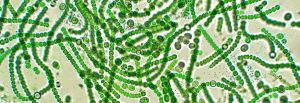
cyanobacteria (photo taken from https://www.deq.ok.gov/state-environmental-laboratory-services/environmental-public-health-information/harmful-algal-blooms/what-are-cyanobacteria/)
If you’re like most people, you’ve probably heard of the world-issue regarding plastics. Giant island sized patches of plastic float on our oceans, to microplastics at the deepest depths. There’s a whole lot of plastic debris and it seems like a colossal issue. The issue of plastic debris waste is affecting food chains from the bottom up, and also is a true visual symbol of how we are not treating our world with the love and respect it deserves. But, my goal here isn’t to tell you how bad it is, or that it is the most important problem facing our oceans, because there are plenty more to think of. Rather, I want to shed light on hope for this problem. That hope is coming from the waters themselves. With a problem as big as this one you might think the solution might be bigger, but if you turn your attention to something much smaller, or maybe a microscope, you’d see what is called microalgae.
In some recent studies published in 2020, the effect of microalgae on certain harmful plastics was reviewed and shown to naturally degrade these plastics and convert those materials into metabolites (sources of energy) (1). The plastics of main interest are LDPE, HDPE, and BPA, with HDPE and LDPE being large sources of plastic waste in our waters (1,2).
These algae could pose a sustainable option compared to other methods that may in turn pollute the environment (i.e. chemical or bacterial removal).
But, how exactly are algae breaking down these plastics? A study by Chia et. al. that was released in October of 2020 explained that these microorganisms use mechanisms already present in their bodies to trigger degradation of plastic materials, and can do so with no artificial intervention; a natural solution to an unnatural problem. Below is a figure highlighting the process

The biodegradation process of algal microbes assimilating plastics (1).
In addition to these algal organisms, some bacteria produce mechanisms that also broke down these plastics, particularly PET, and genetic modification has been considered to transfer these mechanisms to algae.
A group of researchers even managed to transfer genes from bacteria that can break down the high demand/polluted plastic PET into a green algae, avoiding the obstacle of introducing the bacteria in marine habitats and risking biological pollution from the bacteria.
So, if research shows this breakdown is possible by algae, why hasn’t it happened already? Although it is indeed exciting, the current pace at which algae can degrade plastic on its own is relatively slow (2), and therefore it would likely take quite some time to solve our problem. I believe that this information alone will not solve the problem, but it is what we can do with information on algae that gives us some hope of combatting this plastic problem in the future. Until then, we must conduct more research into exactly how effective these algae can be in degrading plastics/microplastics and if they alone can sustain the burden of this pollution.
References:
1. Barone, G. D., Ferizovi´c, D., Biundo, A. & Lindblad , P. Hints at the Applicability of Microalgae and Cyanobacteria for the Biodegradation of Plastics. Sustainability 12, (2020).
2.Chia, W. Y., Tang, D. Y. Y., Khoo, K. S., Lup, A. N. K. & Chew, K. W. Nature’s fight against plastic pollution: Algae for plastic biodegradation and bioplastics production. Environmental Science and Ecotechnology 4, (2020).
3. Kim, J.W., Park, SB., Tran, QG. et al. Functional expression of polyethylene terephthalate-degrading enzyme (PETase) in green microalgae. Microb Cell Fact 19, 97 (2020). https://doi.org/10.1186/s12934-020-01355-8